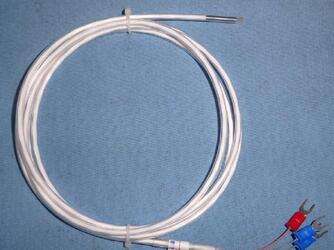What are RTD temperature sensors?

RTDs - or Resistance Temperature Detectors - are temperature sensors that contain a resistor that changes resistance value as its temperature changes. The most popular RTD is the Pt100. They have been used for many years to measure temperature in laboratory and industrial processes, and have developed a reputation for accuracy, repeatability, and stability.
Most RTD elements consist of a length of fine coiled wire wrapped around a ceramic or glass core. The element is usually quite fragile, so it is often placed inside a sheathed probe to protect it. The RTD element is made from a pure material whose resistance at various temperatures has been documented. The material has a predictable change in resistance as the temperature changes; it is this predictable change that is used to determine temperature.
The pt100 is one of the most accurate temperature sensors. Not only does it provide good accuracy, it also provides excellent stability and repeatability. Most OMEGA standard pt100 comply with DIN-IEC Class B. Pt100 are also relatively immune to electrical noise and therefore well suited for temperature measurement in industrial environments, especially around motors, generators and other high voltage equipment.
RTD Standards
There are two standards for Pt100 RTDs: the European standard, also known as the DIN or IEC standard, (RTD Temperature vs. Resistance Table) and the American standard (RTD Temperature vs. Resistance Table). The European standard is considered the world-wide standard for platinum RTDs. This standard, DIN/IEC 60751 (or simply IEC751), requires the RTD to have an electrical resistance of 100.00 O at 0°C and a temperature coefficient of resistance (TCR) of 0.00385 O/O/°C between 0 and 100°C.
There are two resistance tolerances specified in DIN/IEC751:
Class A = ±(0.15 + 0.002*t)°C or 100.00 ±0.06 O at 0ºC
Class B = ±(0.3 + 0.005*t)°C or 100.00 ±0.12 O at 0ºC
Two resistance tolerances used in industry are:
1/3 DIN = ±1/3* (0.3 + 0.005*t)°C or 100.00 ±0.10 O at 0ºC
1/10 DIN = ±1 /10* (0.3 + 0.005*t)°C or 100.00 ±0.03 O at 0ºC
Learn more about this formulas here. The larger the element tolerance, the more the sensor will deviate from a generalized curve, and the more variation there will be from sensor to sensor (interchangeability).